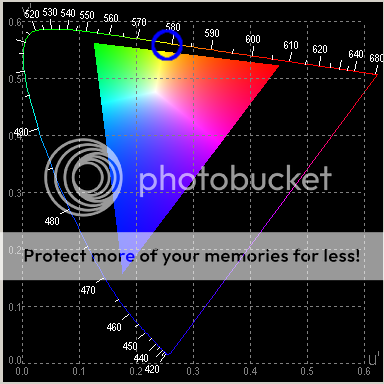George Takei: Introducing our Quattron Technology. It adds yellow to the standard RGB colour system(1) for colours never before seen on TV.
Notice the lifelike colour on this yellow seahorse.(2) Oh, sorry, yellowish seahorse, on your TV with 3-colour technology.
Observe the stunning blue sea, in your mind that is.(3)
Well you get the picture.
Actually, you don't.
Voiceover: Quattron from Sharp. You have to see it, to see it.
(1) It's perfectly possible to produce yellow using the RGB system. You simply mix red and green. Yellow's called a 'secondary' color, since it requires two 'primary' colours to make it.
(2) Looks fairly lifelike to me, both on my TV and on my Laptop. Both of which have reduced Gamuts compared to that visible to the human eye.
(3) Why bother - it's there in front of me. And anyway - there's no yellow in blue - see below.
Another solution looking for a problem to solve, Sharp's latest gimmick is their latest attempt to part customers with their money.
A 'gamut' is the range of colours a particular device/organ is capable of observing/producing, and is typically represented on an graph, thus[1]:
The diagram above represents the range of the typical human eye.
Now, clearly a TV cannot reproduce the full range of what a human eye can see, so the range of a TV is a subset of this:
There is a formal standard for TV's and monitors to 'adhere' to which is called the 'EBU' (European Broadcasting Union) color triangle. That's what this diagram above represents. Any self-respecting TV manufacturer ensures that their TV's can produce all the colours in that triangle.
The corners of the triangle is what you'd see if only all the red, blue or green lights were on on your TV.
Going along the edges are when two of those colors are on, and the bit in the middle is a mixture of all three.
Where does Quattron fit into this diagram? Well...
Quattron is trying to convince you that the area highlighted with a blue circle (and only the bit between the straight line between green and red, and the outside of the gamut for the human eye) is so vast, and so great, that you'll easily spot the difference between a Quattron TV, and a normal TV, and that what you won't be seeing is overexaggerated yellows.
Worth the extra money? I'll let you decide.
And quite how the extra yellow makes the sea any bluer (point 3 above) is a complete mystery, since you can see from the gamuts that they're diametrically opposed to each other.
[1] Diagrams produced using the software from http://www.efg2.com/Lab/Graphics/Colors/Chromaticity.htm




If you can see a T.V advert on your current T.V that is good enough to make you wish to buy the advertised product, then it is good enough not to need the new one.
ReplyDeletelieutenant sulu would not tell a fib!
ReplyDeleteAnon - I think that's Spock you're thinking of.
ReplyDeleteHikaru Sulu, being human (specifically Japanese from Pikiweedia as I type,) is perfectly capable of telling lies.
As the actor who played him demonstrates above.
"Your eye doesn't have any 'yellow' receptors, only red, green and blue."
ReplyDeleteYour eye doesn't have red, green and blue cones. It has long, medium and short cones. Each cone sees a range of colours (e.g. short can see from violet to blue) rather than a single colour. Violet is a very good example because it contains no red, no green, and it's not blue. It's a shorter wavelength (higher frequency) than pure blue.
And yes, RGB televisions can not reproduce pure violet. Only a muddy approximation which is more purple than violet.
Oops - well spotted.
ReplyDeleteI was trying to allude to the fact that yellow wasn't a primary colour (as far as light is concerned) and is simply a mixture of red and green.